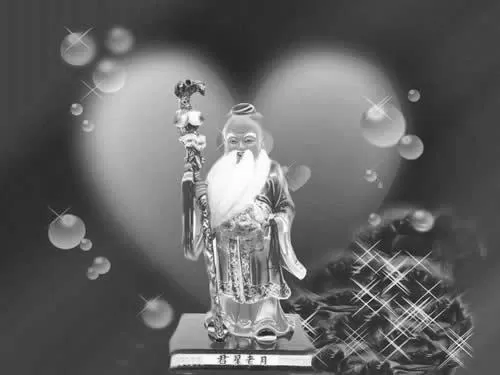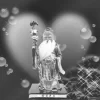A Chinese deity is a god who governs the world and relates to both the male and female aspects of a relationship. Many of these deities are also associated with marriage and love. Yue Lao is one of the most famous. He appears as a spectral old man in the moonlight and ties future couples together with red strings. One of his most famous legends is about a young man who challenged a marriage he was foretold to have. He ended up stabbing the young girl who was to be his future wife.
Yue Lao
If you’ve been looking for a good life partner, you should consider contacting Yue Lao, a Chinese deity of love and marriage. The ancient Chinese believed in fate and the future, and that even before birth, people were destined to marry. A book of fate was said to record future couples, and Yue Lao was tasked with pairing them up. When couples were matched, she used a red string to bind them together. Attempts to undo the ties would lead to disaster.
Yue Lao is also known as the “Old Man Under the Moon.” His full name is Yue Xia Lao Ren, and his short form, Yue Lao, means “old man under the moon.” This is the most popular version of Yue Lao, though it’s not the only version.
Yue Lao is similar to other love deities in the West, although in China he appears as an old man in the moon. He ties future couples together with red strings, and his most famous tale involves a young man challenging his foretold marriage and stabbing the girl he was destined to marry.
The most popular version of the story is from the Tang Dynasty. It tells the story of a man who tried to marry a girl without believing in the Love God. He attacked the girl, hoping to get her, but ended up leaving her with a scar from the attack. Eventually, many people began to believe in Yue Lao and started to marry according to their destiny.
In the ancient times, Yue Lao knew the fates of people from childhood. The legend says that Yue Lao actively tried to arrange their marriages before they were ten years old. This was unusual for young people in China, as they typically had no say in who they married.
Xia Hai temple
Located just 40 minutes from Taipei, Xia Hai temple is home to a deity that is considered to be the god of marriage and love. This deity is known as the Old Man Under the Moon or Yue Xia Lao Ren. During his long life, the deity has been helping people find love and marriage. Today, this temple is a popular destination for Chinese and Japanese tourists alike.
The Xia Hai temple has been around for over a century and contains statues of more than 600 deities. This is the highest statue density of any temple in Taiwan. One of the most popular statues in the temple is a giant Chinese Cupid that is said to be able to encourage marriage. This temple is particularly popular with singles looking for their significant other. Many couples come to worship this deity to ensure that their wedding will go smoothly and be blessed by the gods.
The temple is also home to a number of other Chinese deities, including the City God. Located in the old town of Taipei, this temple was originally a Taoist temple but now worships Buddhist deities. In addition to worshipping the City God, the temple offers protection for its followers.
In the past, men comprised only about 30 percent of temple visitors, but this number has risen to more than 40 percent. Those who are single may also seek to obtain blessings from the deity for another marriage, or seek the god’s help during old age.
The Xia Hai temple also holds a special ceremony where married couples can buy Fortune Shoes, which they consider a prayer for a happy marriage. This ceremony also includes a blessing for the family.
Caishen
Caishen is one of the most popular gods in China. His worship is said to guarantee good fortune for the year ahead. However, his symbolism shows that just invoking him is not enough to achieve financial prosperity. There are many other things a person must do to ensure financial prosperity. In addition to his wealth-attracting powers, Caishen is associated with tigers. In Chinese art, tigers have many attributes, including perseverance.
As the god of wealth and prosperity, Caishen is a favorite among Chinese merchants. His statues can be found in Chinese merchants’ businesses around the world. Most of these statues depict a rich man in a silk robe holding treasures. He is sometimes accompanied by two attendants carrying bowls of gold. While Caishen was a god of material wealth, he was also a wise steward of his wealth.
In ancient China, worship of Caishen was widespread. People would give offerings and pray to her on a regular basis to earn her blessings. Caishen temples were among the most popular in the country. Caishen also symbolized the union of two people.
Nestle had argued that there was no direct connection between the trade mark and Caishen. However, the court disagreed, stating that Caishen is a key symbol of traditional Chinese culture. Therefore, the court rejected Nestle’s appeal. The court upheld the TRAB’s decision to deny the trade mark application.
The goddess of marriage and love is also associated with a couple. The goddess of the sea helped save people from danger on boats and became the patron of fishermen and sailors. She was one of the most popular deities in China, beloved by both men and women.
Yan Wang
The deity of marriage and love in Chinese mythology is called Yue Lao. This enthroned deity wears a long, white beard and imperial robes. He carries a red silken rope which he uses to bind predestined couples together. The legends surrounding his appearance indicate that he was created by a young man named Wei Gu. Wei Gu was lamenting the lack of a wife when he accidentally came across the god Yue Lao.
The deity was first worshipped in the fourth century. In addition to her religious significance, she is also revered as the patron of fishermen and sailors. As a result, she has become one of the most popular deities in China. Both men and women worship her. Her heavenly attributes allow her to influence the lives of Chinese people.
The deity was originally from Hangzhou. He was a poor shepherd but learned the Taoism from an immortal and eventually achieved immortality. His image is most popular in Hong Kong, where it was brought by a traditional Chinese medicine practitioner in the early nineteenth century. It has since been revered by people throughout the world.
This deity was the highest power of the Chinese mythology. She took the form of the wife of the Jade Emperor, and was entrusted with many tasks. These included controlling the other female gods, tending the Peaches of Immortality in the palace gardens, and sending couples babies. Her appearance was often depicted in two forms: a beautiful woman with sharp teeth or an old woman with a hunched back. She could also have leopard-like tail or tiger-like teeth.
Another Chinese deity is Nu Wa. This were-snake goddess is influential since ancient times and has a crucial role in Chinese mythology. During Chinese New Year, people invoke her to bring prosperity in the coming year. Many people also invoke her during spring cleaning. They are advised not to sweep the front door as they may sweep away her blessings.
Chang’e
The Chinese deity of marriage and love, Chang’e, is known as the goddess of longevity, beauty, and love. The story behind her birth is told as the origin of the Mid-Autumn Festival. In the distant past, Chang’e was a beautiful woman who was married to an archer called Hou Yi. The two fell in love and were married. However, ten suns scorched the Earth, forcing the ancient Chinese to endure hardship.
The legend of Chang’e dates back to ancient China. She was the wife of the most powerful archer Hou Yi, who shot nine of ten suns. She was so powerful that the goddess Xiwangmu offered him an elixir of immortality, but Hou Yi refused. Chang’e was displeased, but she didn’t want to live without her husband.
The story of Chang’e and Hou Yi is celebrated during the Mid-Autumn Festival. During this time, lovers leave moon-cakes or fruit under the full moon to honor the moon goddess. While the romantic version is widely popular, older versions of the story are far more sinister and dark.
In Chinese tradition, Chang’e is the god of marriage and love. She is also linked to the Moon Festival, which occurs on the eighth lunar month on the 15th day. The festival is a time of reflection. During this time, people leave food and offerings for Chang’e and her pet rabbit.
The legend of Chang’e is a popular one. Although she is the wife of a famous Chinese archer, the tale is more than just a story of a happy marriage. She also ends the relationship in an unusual way. The story of Chang’e and Hou Yi’s relationship varies, and the ending and beginning of the story are different in each version.







